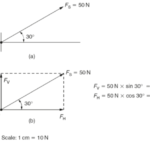Basis of Physics Subject Basis of Physics Subject
What is Physics
Physics is the most basic science, which deals with the study of nature and natural phenomena.
Understanding Scope of Physics
The extent or scope of physics can be understood if one looks at its various sub-disciplines such as mechanics, optics, heat and thermodynamics, electrodynamics, atomic physics, nuclear physics, etc.
Forces of Nature
Force is the external agency applied on a body to change its state of rest and motion
Basis of Measurement
To understand the properties of materials, measurement of physical quantities such as length, mass, time etc., are involved.
Expressing larger and smaller physical quantities
In the metric (SI) system these are related to the fundamental unit in multiples of 10 or 1/10. Thus 1 km is 1000 m and 1 mm is 1/1000 metre.
Determination of Mass
The mass can be determined to an accuracy of 1 mg. Nowadays, digital balances are used to find the mass very accurately.
Determination of Distance
For measuring large distances such as the distance of moon or a planet from the Earth, special methods are adopted.
Measurement of Time
Some techniques to measure time interval are
Accuracy and Precision of Measuring Instruments
The accuracy to which a measurement is made depends on several factors. For example, if length is measured using a metre scale which has graduations at 1 mm interval then all readings are good only upto this value.
—————————————————————-
Kinematics Kinematics
What is Kinematics
It deals with the study of particles or bodies when they are at rest or in motion.
Motion in one dimension (rectilinear motion)
The motion along a straight line is known as rectilinear motion
Scalar and Vector quantities
A study of motion will involve the introduction of a variety of quantities, which are used to describe the physical world. Examples of such quantities are distance, displacement, speed, velocity, acceleration, mass, momentum, energy, work, power etc. All these quantities can be divided into two categories – scalars and vectors.
Projectile motion
body thrown with some initial velocity and then allowed to move under the action of gravity alone, is known as a projectile.
Concurrent forces and Coplanar forces
The basic knowledge of various kinds of forces and motion is highly desirable for engineering and practical applications. The Newton’s laws of motion defines and gives the expression for the force. Force is a vector quantity and can be combined according to the rules of vector algebra.
Uniform circular motion
When a particle moves on a circular path with a constant speed, then its motion is known as uniform circular motion in a plane.
Newton’s laws of motion
There are three laws of motion. A deep analysis of these laws lead us to the conclusion that these laws completely define the force. The first law gives the fundamental definition of force; the second law gives the quantitative and dimensional definition of force while the third law explains the nature of the force.
Work
In physics, work is said to be done by a force or against the direction of the force, when the point of application of the force moves towards or against the direction of the force.
Energy
Energy can be defined as the capacity to do work. Energy can manifest itself in many forms like mechanical energy, thermal energy, electric energy, chemical energy, light energy, nuclear energy, etc.
Collisions
A collision between two particles is said to occur if they physically strike against each other or if the path of the motion of one is influenced by the other. In physics, the term collision does not necessarily mean that a particle actually strikes.
——————————————————————————
Dynamics of Rotational Motion Dynamics of Rotational Motion
A point in the system at which whole mass of the body is supposed to be concentrated is called centre of mass of the body.
Centre of Mass
The inability of a material body to change its state of rest or of uniform motion by itself is called inertia
Rotational motion of rigid bodies
A rigid body is defined as that body which does not undergo any change in shape or volume when external forces are applied on it. When
forces are applied on a rigid body, the distance between any two particles of the body will remain unchanged, however, large the forces may be.
Moment of inertia and its physical significance
The inability of a material body to change its state of rest or of uniform motion by itself is called inertia
Couple and moment of the couple (Torque)
The two forces always have a turning effect, or moment, called a torque. The perpendicular distance between the lines of action of two forces, which constitute the couple, is called the arm of the couple.
Moment of a force
This tendency of rotation is called turning effect of a force or moment of the force about the given axis.
Angular momentum of a particle
The angular momentum of a particle is defined as the moment of linear momentum of the particle.
Relation between torque and angular acceleration
The rate of change of angular momentum of a body is equal to the external torque acting upon the body
Conservation of angular momentum
When no external torque acts on the body, the net angular momentum of a rotating rigid body remains constant. This is known as law of conservation of angular momentum.
————————————————————
Gravitation and Space Science Gravitation and Space Science
he fundamental forces of nature are gravitational, electromagnetic and nuclear forces.
Introduction to Gravitation and Space Science
The acceleration produced in a body on account of the force of gravity is called acceleration due to gravity.
Acceleration due to gravity
The acceleration due to gravity depends on the mass of the body, the distance from the center of mass, and a constant G, which is called the “universal gravitational constant”.
Acceleration due to gravity at the surface of the Earth
Its distance from the centre of the Earth is R (radius of the Earth).
Variation of acceleration due to gravity
Earth rotates about an axis passing through its north and south poles. The Earth rotates from west to east in 24 hours.
Gravitational field
The gravitational field is defined as the space around a mass in which it can exert gravitational force on other mass.
Gravitational potential energy
The gravitational potential energy of a mass m at a distance r from another mass M is defined as the amount of work done in moving the mass m from a distance r to infinity.
Inertial mass
Intertial mass of a body is a measure of the ability of a body to oppose the production of acceleration in it by an external force.
Gravitational mass
Gravitational mass is the mass of a body which determines the magnitude of gravitational pull between the body and the Earth.
Escape speed
The escape speed is the minimum speed with which a body must be projected in order that it may escape from the gravitational pull of the planet.
Satellites
A body moving in an orbit around a planet is called satellite.
The Universe
The science which deals with the study of heavenly bodies in respect of their motions, positions and compositions is known as astronomy.










